2nd November 2007
 Wednesday, November 21, 2007 at 09:05AM
Wednesday, November 21, 2007 at 09:05AM
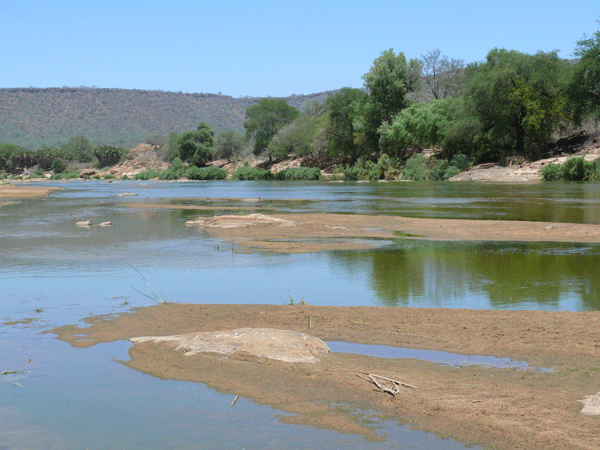
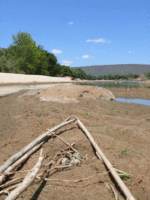
Three Eggs in Plover Nest
Can you believe it? Another pair of Spur-winged Plovers is nesting, this time in sight of our house. With binoculars, we can just see the nest from the balcony – it’s on a small sand island, in the middle of the river. (You can just see the nest in the foreground of the above photo). It goes without saying that this is a high-risk location: if it rains upcountry, raising the river level, it won’t be long before the sand island is underwater. (Perhaps the plovers know more than we do about the weather, and this is an indication that the little rain we’ve had so far is all we’re going to get this year?). And then, if and when the chicks do hatch, how are they going to get them across the water to dry land? Will the little things float? Or do the Plovers know that the weather is going to get even hotter and drier, so that the arm of the river between the island and the mainland is going to dry up completely before the chicks hatch? Such knowledge would seem too far-fetched, but one does wonder why the Plovers would choose to nest in such a precarious place as a low island in a river prone to flooding.
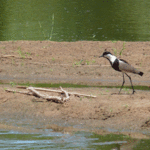
Plover parent returning to its nest
My father and I went down with the camera to have a quick look at the nest, which is situated inside a triangle of old reed stalks, which have washed up on the island there. It looks remarkably like someone has deliberately placed the stalks around the nest to protect it, but I can assure you we are the only people here, and we didn’t even spot the nest until today. There are three eggs in the nest, which means it must have been there for at least three days, for Plovers generally don’t lay more than one egg a day. While I was there, I counted five Plovers all in the one area – I am guessing this is the nesting pair, and another pair with a much older chick – quite probably the older chick which we saw a while back on our evening stroll down the sandbank.
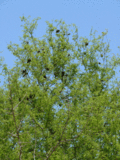
Ant Nests
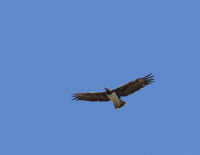
Martial Eagle in Flight
In order not to disturb the Plovers too much, we decided not to walk down the beach from the house, but to go the back way, and come down to the riverbank through the trees. I photographed these black “blobs” in the acacia trees, which we can only guess are ants nests. A Martial Eagle flew overhead – an adult bird – no doubt on the lookout for dik-diks or other unsuspecting prey.
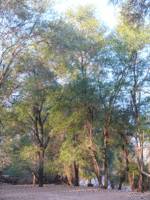
The Peaceful Place
Just before reaching the riverbank, we passed through one of my favourite spots on our property – somehow it has a very special atmosphere all of its own. It’s a wide flat sandy area, shaded by huge acacia trees, and always full of birds, and often with a few dik-dik enjoying the shade and the cover. Inevitably it’s an incredibly peaceful place, despite the cacophony of birds. Today, when we arrived there, a troop of baboons was just passing through. We saw (and heard the screeching of) Orange Bellied Parrots who appear to be nesting in a hole in one of the acacia trees. Although we did not see the Parrots enter the nest, we could tell the hole was being used by the scratch marks around the edge. The size of the hole – quite large – suggested it was Parrots that were nesting there. I intend to go back at some stage, and just sit and wait and watch. A Drongo was flitting around for insects – its tail was not quite as forked as the common Fork Tailed Drongo that we see all the time around the house, so I must remember to check if this is a different species. Its tail was more rounded at the end, the fork not quite so pronounced. [Later: It turns out that this was a juvenile of the Fork Tailed Drongo – the tail only becomes sharply forked when the bird reaches adulthood.] And then there was a Honey Guide, with its chattering call, a pair of vocal Von der Decken Hornbills, and the Go-Away Birds who are so-called because of their piercing cry which sounds like “go-away-go-away” – and we saw a Glossy Starling chasing a Cuckoo – so a couple of new birds to add to my Kulafumbi Bird List. I also photographed a Grey Headed Kingfisher – so lovely with its long red beak and flashes of blue on the wing.
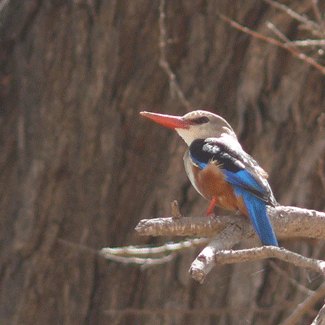
The small “palm-like” plants in our balcony flowerbed had their fan-shaped leaves open today, like a gathering of elegant Japanese ladies. (In dry times, the plants close up their leaves to minimise water loss).
I’m also cultivating some moss patches in the balcony gardens – in the wild, this moss just grows on the hard earth, often in rocky areas, and turning green only in the rains. I dug some up and placed it in some of the flowerbeds. It does seem to be growing a little around the edges – I’m longing to see whether it will spread in amongst the other plants.
Good news: the yellow-barked Acacia Xanthophloea tree, which we planted by the birdbath, has started to sprout, after shedding all its leaves when we first placed it there. I think this means the transplant has been a success, and the little tree will now thrive.
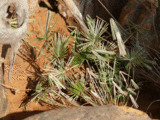
Palm-like plants, leaves open
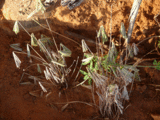
Palm-like plants with leaves closed
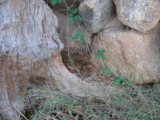
Moss Garden
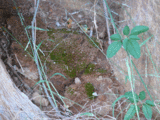
Moss Garden (close-up)
PM
This evening we saw large leopard spoor on the “Little Serengeti” – looks like a male, as the pug marks were much larger than those of the small female we often see on the sand below the house. The dik diks were out on the sandbank, and we sat in the trees on the river’s edge (near The Peaceful Place) and managed to get some shots of the tiny antelope, without them realising we were there.
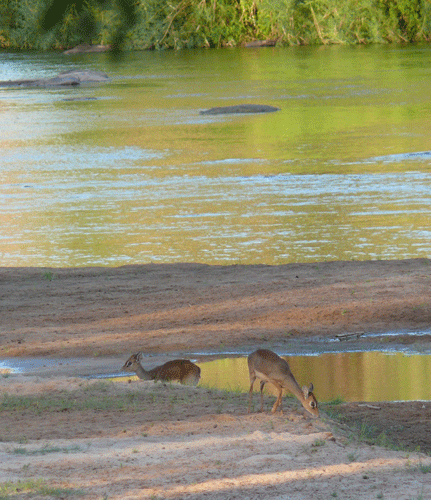
See more photos of our Balcony Flowerbeds, with their weird and wonderful wild plants...
See more photos of Dik-Diks on the beach, and other antelope...





Reader Comments (5)
Thanks for sharing wonderful information, I really enjoyed this article and wish more contents on the topic.
Your article is really informative. I will surely bookmark it for future reference. Good work! Keep it up.
Wonderful ! wah such a great article
wonderful article. thanks a lot for sharing such a informative article. nice work, keep it up.
Nice post, I would like to bookmark it.
Is it only possible on dry land. thanks